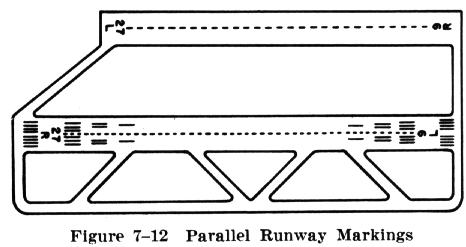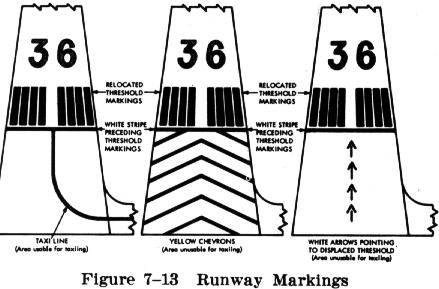| Runway and Taxiway Markings
In the interest of safety and efficiency of aircraft operations, the FAA has established for the guidance of pilots, standard runway and taxiway markings. Since most airports are marked in this manner it is important for the pilot to learn the meaning of the markings and how to use them. Standard runway markings are painted in reflective white, while
markings of taxiways and nontraffic areas such as blast pads and overruns are in
reflective yellow.
An overrun or blast pad area at the approach end of a runway is marked by a series of equally spaced yellow chevrons to indicate the portion not usable for takeoff or landing. The apex of the chevrons points to and terminates at the threshold of the usable portion of the runway. When it has been necessary to position the landing threshold up runway from the end of the paving, it is known as a relocated or displaced threshold. There are two methods of marking this area (Fig. 7-13). When the paved area on the approach side of the relocated threshold is to be used only for taxiing, all markings indicating that the area was usable as a runway are obliterated. When the paved area on the approach side of the relocated threshold is not to be used for taxiing, this area is marked in the same manner as overrun or blast pad areas, as previously discussed. Where thresholds are displaced, the unusable portion is marked with a series of large white arrows. The arrows are placed along the centerline on the approach side of the relocated threshold and point to the designated landing area. In all cases a white stripe across the width of the full strength runway precedes the threshold markings. Never land short of the stripe. Runway shoulders which have been stabilized with materials that give the appearance of firm paving but are not intended for use by aircraft, are marked with a series of partial yellow chevrons. The taxiway centerline is marked with a continuous yellow line. The edges of the taxiway are sometimes marked with two continuous lines 6 inches apart. Taxiway HOLDING LINES consist of two continuous lines and two dashed lines perpendicular to the centerline. Pilots should stop short of the holding line for runup or when instructed by ATC to "HOLD SHORT OF (runway, ILS critical area, etc.)." Aircraft exiting a runway are not clear of the runway until the aircraft has passed the runway holding line.
|


